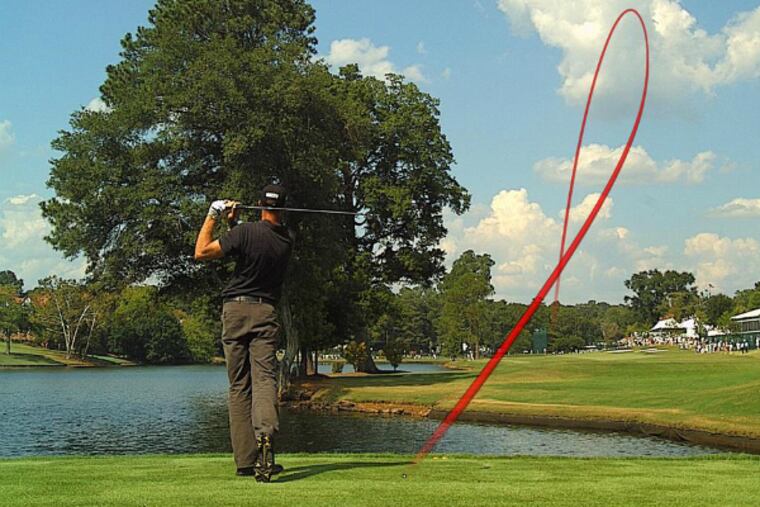'Wow' is a factor for golf producer
TV producer Tommy Roy incorporates Protracer and PinPoint animation, enhancing the golf-watching experience.

STEVE STRICKER stood in the fairway on the second hole at Merion, one shot back on Sunday at the U.S. Open. He needed to nail this shot.
Instead, Stricker shanked a 4-iron. His ball went screaming over Ardmore Avenue, out of bounds, and Stricker fell out of contention with a triple-bogey.
An indicting red line cut an ugly scar across TV monitors worldwide. Tommy Roy, the man responsible for the red line, felt his heart sink.
"Probably the most dramatic and most painful Protracer shot of all time," Roy said. "He was done."
Roy felt a kinship with Stricker, then a 46-year-old short hitter with a diabolical short game and a gentlemanly demeanor. Stricker would have been the oldest U.S. Open champ. Roy, 56, has seen thousands of bad shots in his time, but that particular red line cut him to the quick.
"Really disastrous," Roy said.
Roy used Protracer animation on five tees and perched another behind the diabolical 17th island green, the better to trace every thrilling second of golf's most chilling shot.
On every hole Roy had available PinPoint animation, which maps every grain of sand and blade of grass and can track every putt on every green. He often dialed up X-Mo super-slow-motion on tee shots that showed golf balls compressing like marshmallows.
"I like that 'wow' factor," Roy said.
He has mastered the "wow" factor of all of these toys over the past 5 years; none more effectively than the technology that gives texture to what was, for more than 60 years, invisible.
Suddenly, viewers who once saw nothing but a little, white ball against a cloudless, blue sky could follow the ball's vector toward disaster or glory.
It mapped the tee shots of Fowler, Sergio Garcia and Kevin Kinser on No. 16, the first playoff hole, and displayed their nerves: Each one flared his tee shot into the right rough.
It charted Fowler's three laser shots into No. 17, which landed a combined 16 feet from the protected, back-right hole, which set up three otherworldly birdies.
Cool, right? So, the obvious question:
Why not use all of that technology on every hole, every week? Last week, it unraveled the complexities at TPC Sawgrass, which consistently is golf's fairest test; a tournament with an unmatched field, played on a course that demands every shot from a high fade to a low draw.
Two answers: aesthetics and, said Roy, "Cost."
Roy produces a pastoral television experience in which every blade of grass and every leaf are presented in high definition. While some viewers clamor for ever more gimmicks, Roy finds the balance between enhancement and distraction.
"The tipping point is when you feel you have too many graphics on the screen," Roy said. "We could be CNBC, with the ticker and all that stuff, but one of the great attributes of golf is nature. You don't want to junk the screen up with a bunch of graphics."
Also, technology is expensive.
At the Players, Roy used the Protracer at the tees on Nos. 2, 6, 10, 13 and 16. Note the consistency of the spacing. Roy has just one Protracer setup (he snared another for the shots at No. 17).
"You'd have to have multiple systems," said Roy, who declined to say how much his setup costs. "By the time you unhook it, throw it in the golf cart, run it up to the next tee place you need it - you need at least two or three holes [ahead] to do that."
The PinPoint animation might be more easily used repeatedly - the English company maps out every green in 6-inch increments - but not every putt merits 3-D enhancement.
"A lot of them are just straight putts with no elevation change," said Roy, who often saves the technology for the biggest players in the biggest moments. "I use it on big breaking putts, or if a putt has to come over a rise."
X-Mo and PinPoint are cool, but none of the technology resonates like the Protracer, best employed for demanding shots.
"I try to use it on holes where players have to work the ball: hit a left-to-right shot or a right-to-left shot," Roy said.
There are exceptions.
Roy used Protracer to track the third-round holes-in-one by Dustin Johnson, then J.B. Holmes, at the Cadillac Championship at Doral in March. They dropped their aces in an unprecedented 24-minute span at the treacherous, 204-yard No. 4 hole; Protracer showed every millisecond of their flight, and an overlapping screen shot let the viewer see differences in trajectory and line.
It was Comic Con cool; a slick rarity in the stuffy world of golf. It is exactly the sort of techy carrot that golf needs to attract a younger audience, which could then more easily follow each shot.
Sometimes, as with Fowler, Holmes and Johnson, whose ace eventually won him the tournament, that little line describes an arc to glory. Sometimes, as with Stricker, it traces a path to doom.
But it always adds to the experience.